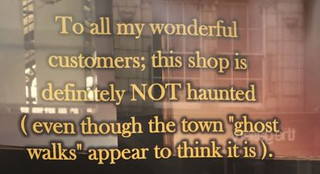
PREV ARTICLE
FULL ISSUE
PREV FULL ISSUE
MR. SQUIRREL'S TIME-TRAVELING COIN ENVELOPESGreat Yarmouth is a seaside resort town in Norfolk, England. This article recounts the odd Twilight Zone story of a coin collector's shopping experience. -Editor
It was when he approached the till that he noticed the shop was strangely old-fashioned: despite it being 1973, the lady behind the desk was in Edwardian dress. The wonderfully-named Mr Squirrel had, according to an account in Norfolk author Joan Forman's book The Mask of Time, popped into a Great Yarmouth shop after a recommendation from a friend. This story is from sources which quote from Ms Forman's book, Legends and Things That Go Bump in the Night by S John Saunders and Norfolk Stories of the Supernatural by Betty Puttick. Back to Mr Squirrel, who had stepped into the smartly-painted shop from a traditionally cobbled road and noted almost straight away that inside it seemed quaintly old-fashioned – inside there was complete silence, the traffic outside had melted away entirely. Keen to buy transparent envelopes to keep individual coins in, he went to ask for help at the till – a young woman stepped forward to help. She was wearing a blouse with a cameo brooch at her neck, her hair was scraped back into a bun and her skirt was long and swished to the floor. Mr Squirrel asked for the coin envelopes and she produced them, noting that they were also used by fishermen to keep their hooks in – he bought 36 for a shilling, nodded his thanks and left the shop. Within a week, and having catalogued 36 coins, he found himself in need of more envelopes and set out once again for the old-fashioned shop. When he arrived, he was perplexed to see paving slabs instead of cobbles, a drab frontage instead of smart paint: inside, a much older woman stepped forward to serve him and, when asked for the envelopes, said she didn't stock them. Mr Squirrel mentioned the lady he had seen a week earlier only to be told that no such assistant worked at the shop – in fact, the lady he was speaking to was the sole assistant and had been for many years. The story became even stranger: when Mr Squirrel took the envelopes he had bought on his first visit to an expert, they dated them and said they were around 10 to 15 years old, although did say that cellulose had been around since the 1920s. And then there was the question of payment: by 1973, decimalization had been introduced, although shillings were still legal tender with a value of 5p until December 31 1990. Mr Squirrel thought back and estimated that the shop seemed to be similar to those that were commonplace in the early 1900s... yet the envelopes were younger and the form of payment younger still. Even rarer still in the cases of time slips: Mr Squirrel had brought something back, seemingly from another period of time entirely. Ms Forman suggested that Mr Squirrel had experienced a timeslip: his grandfather had also been a coin collector, and possibly might have visited the same shop. Were grandfather and grandson's memories merged? Or had Mr Squirrel simply visited two different shops and made a mistake? He was adamant this was not the case. Everyone likes a good story, but curious about its background I reached out to UK reader and contributor David Pickup. -Editor David writes: "I have not heard this tale. There is a very similar H G Wells short story about a magic shop. "I think someone is having someone on. If a friend recommended him to the shop what did they say about it? "What is the expert in envelopes? I have never heard of an expert like this. "I have never heard of anglers keeping hooks in plastic envelopes either or coin sized paper ones. "Although 5 p was called a shilling in the 1970s the coin he used to pay to pay the ghost was unlikely to be an Edwardian one. What would the ghost do with the coin? Find a ghostly bank to pay it in? or a ghostly parking meter to pay for parking her ghostly carriage? "A shilling in 1900 would be about £6.00 today which is quite a lot to pay for a few envelopes. "The following is a story about "Ghost tours" being promoted in this seaside town."
To read the complete article, see:
THE BOOK BAZARREWayne Homren, Editor The Numismatic Bibliomania Society is a non-profit organization promoting numismatic literature. See our web site at coinbooks.org. To submit items for publication in The E-Sylum, write to the Editor at this address: whomren@gmail.com To subscribe go to: https://my.binhost.com/lists/listinfo/esylum All Rights Reserved. NBS Home Page Contact the NBS webmaster 
|

